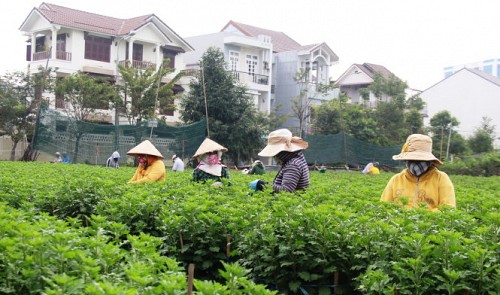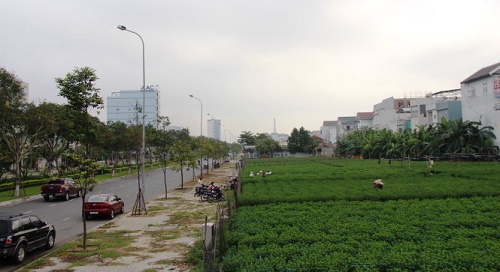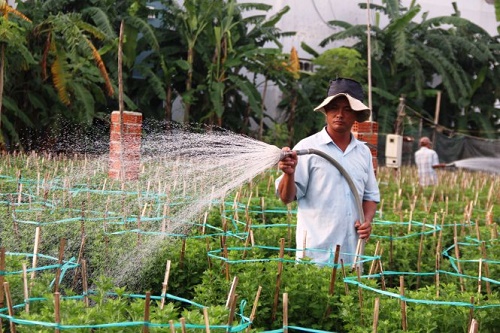Da Nang farmers benefit from growing flowers in 'golden' land
Dozens of farmers in Da Nang have been able to earn good incomes from growing flowers on unused land pieces at ‘golden’ locations while beautifying the hub at the same time.
Flower farms seen along such streets such as April 30, Luong Nhu Hoc, Nguyen Huu Tho and Huynh Tan Phat, located in Hai Chau District, or on unused land plots in residential areas in Son Tra and Cam Le Districts, are now ready to bloom in time for Tet (Lunar New Year).
Before and during Tet, which will kick off on February 8, flowers and fruits are traditionally used for decorations, with festive preparations usually beginning around one week before the official Tet date and lingering for another week after that.
The flower beds have created stunning spectacles for the land lots, which are worth several billion dong apiece (VND1 billion = US$44,076).
 |
| Farmers have borrowed unused land on Luong Nhu Hoc Street, a prime spot located in Hai Chau District, to grow flowers, with the backdrop being luxurious edifices. Tuoi Tre |
Phan Van Huy and his family are currently tending to their flower farm, located on a 700-square-meter land plot on Luong Nhu Hoc Street in Hai Chau District in downtown city.
The deserted property has been zoned for a project.
Seeing that it is a huge waste to leave the land vacant, he sought permission from the local government to grow flowers on it.
The man has high expectation that his 1,000 tubs of daisies and a small amount of lilies and marigolds, intended for the Tet market, will earn him VND50 million ($2,203) if the climate is on his side.
The business has landed his family a handsome income over the past five years.
Such farms require painstaking care and acute awareness of weather changes, which can make or break their crops.
As the “golden” land plots are situated next to arteries, T-junctions or crossroads, these growers do not need to rent stalls in Tet flower markets to display their produce for the year’s biggest festive occasion.
Nguyen Van Tri, who has been engaged in the farming model for more than six years now, is happy that his 2,000 pots of daisies, housed in a 600-square-meter land piece at the April 30-Nguyen Huu Tho T-junction, are thriving well.
A job as a construction worker earns him unstable wages, so he has grown flowers on the deserted plot of land every Tet season to earn a considerable additional income.
Tri is also expecting a bumper crop as many have placed orders for his daisies at good prices.
 |
| A luxuriant flower field on a patch of "golden" land on April 30 Street, situated in Hai Chau District. Photo: Tuoi Tre |
Meanwhile, Ho Van Chien, whose 4,000-square-meter flower farm is part of a nice plot on April 30 Street, used to reside on the street before being relocated by the government in 2006 to make the most out of the land bank.
He and several other households then sought permission to germinate flowers on their former land pieces, which remain vacant so far.
He added that several of his regular outlet owners in central provinces including Quang Binh, Quang Tri and Thua Thien-Hue, have partnered with him or made early orders for his floral products.
According to Tran Van Ly, deputy head of the Farmer’s Association in Hoa Cuong Bac Ward, where many of the prime location plots are located, a number of residents were relocated back in 2005.
With work yet to start on multiple housing projects, causing the land to deteriorate and subjecting it to serious pollution, the ward administration came up with borrowing five hectares of land for farmers to grow flowers and vegetables on.
The area was later expanded to 11 hectares, with more than 70 households engaged in the lucrative model, Ly added.
 |
| A farmer tends to his flower beds on a borrowed plot of land at one of the city's prime locations. Photo: Tuoi Tre |
Inspired by Hoa Cuong Bac Ward’s early success, Da Nang Farmers’ Association sought approval from the municipal People’s Committee in lending vacant plots across the city to farmers in late 2008.
Before the model was approved, the deserted land plots looked unsightly and were particularly prone to pollution.
Though the model is cost-effective and profitable, participating growers are constantly on tenderhooks over their inevitable eviction.
Nguyen Phu Ban, head of the city’s Department of Agriculture and Rural Development, revealed that the city has zoned four areas totaling approximately 100,000 hectares in Hoa Vang District for the cultivation of flowers and greens.
“The department will offer incentives to farmers including bank loans and training to facilitate their relocation to the future flower village, and adopt measures to better promote the city’s floral varieties to other cities and provinces,” he stressed.
(Source: Tuoi Tre News)